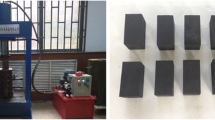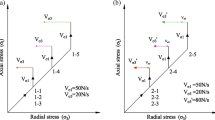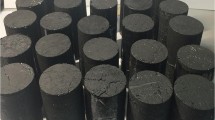Abstract
Coalbed methane, a naturally occurring gas in coal, is regarded as a relatively clean-burning and eco-friendly resource. During mining, coalbed methane may be leaked to the environment, leading to potential coal mine catastrophes such as coal and gas outbursts, and gas explosions. In the interest of mine stability, and to enhance resource recovery and utilisation, it is fundamentally important to understand the permeability characteristics of coal, in particular its post-peak permeability behaviour. In this paper, an in-house developed tri-axial apparatus with the ability to investigate coupled thermal–hydrological–mechanical behaviour under servo-controlled seepage has been used to carry out a series of gas permeation experiments in coal samples. The coal samples were subjected to tri-axial tests, including the simulation of coal extraction by unloading the confining pressure applied on the test specimens. The deformation and permeability characteristics of raw coal during these tests were recorded. The volume changes of the coal samples during the tests were observed to occur in three stages: Stage 1: contraction, Stage 2: little or no volume change, and Stage 3: dilation. Corresponding to the volume changes, the gas seepage can also be divided into three stages: seepage decrease, steady seepage, and accelerated seepage. Based on the observed behaviour of coal samples during the tri-axial permeation tests, an analytical model to simulate damage evolution and its effect on the permeability of coal containing gas is proposed in this paper. It may be used to study the evolution of permeability with stress changes, and to provide insights into coal and gas outbursts in practice.











Similar content being viewed by others
References
Broyden, C.G.: Quasi-Newton methods and their application to function minimisation. Math. Comput. 21(99), 368–381 (1967)
Broyden, C.G., Dennis, J.E., Moré, J.J.: On the local and superliner convergence of quasi-Newton methods. IMA J. Appl. Math. 12(3), 223–245 (1973)
Chen, Z., Liu, J., Pan, Z., Connell, L.D., Elsworth, D.: Influence of the effective stress coefficient and sorption-induced strain on the evolution of coal permeability: model development and analysis. Int. J. Greenh. Gas Control 8, 101–110 (2012)
Civan, F.: Effective correlation of apparent gas permeability in tight porous media. Transp. Porous Media 82(2), 375–384 (2010)
Cook, N.G.W.: Natural joints in rock: mechanical, hydraulic and seismic behaviour and properties under normal stress. Int. J. Rock Mech. Min. Sci. Geomech. Abstr. 29(3), 198–223 (1992)
Cui, X., Bustin, R.M.: Volumetric strain associated with methane desorption and its impact on coalbed gas production from deep coal seams. AAPG Bull. 89(9), 1181–1202 (2005)
Cui, X., Bustin, R.M., Chikatamarla, L.: Adsorption-induced coal swelling and stress: implications for methane production and acid gas sequestration into coal seams. J. Geophys. Res. 112, B10202 (2007)
Ertekin, T., King, G.A., Schwerer, F.C.: Dynamic gas slippage: a unique dual mechanism approach to flow of gas on tight formations. SPE Form. Eval. 1(01), 43–52 (1986)
Firouzi, M., Alnoaimi, K., Kovscek, A., Wilcox, J.: Klinkenberg effect on predicting and measuring helium permeability in gas shales. Int. J. Coal Geol. 123, 62–68 (2014a)
Firouzi, M., Rupp, E.C., Liu, C.W., Wilcox, J.: Molecular simulation and experimental characterization of the nanoporous structures of coal and gas shale. Int. J. Coal Geol. 121, 123–128 (2014b)
Flores, R.M.: Coalbed methane: from hazard to resource. Int. J. Coal Geol. 35(1), 3–26 (1998)
Gough, C., Shackley, S., Cannell, M.G.R.: Evaluating the Options for Carbon Sequestration. Tyndall Centre for Climate Change Research, Norwich (2002)
Liu, H.H., Rutqvist, J.: A new coal-permeability model: internal swelling stress and fracture–matrix interaction. Transp. Porous Media 82(1), 157–171 (2010)
Liu, J., Chen, Z., Elsworth, D., Miao, X., Mao, X.: Evolution of coal permeability from stress-controlled to displacement-controlled swelling conditions. Fuel 90(10), 2987–2997 (2011)
Palmer, I., Mansoori, J.: How permeability depends on stress and pore pressure in coalbeds: a new model. SPE Reserv. Eval. Eng. 1, 539–540 (1998)
Palmer, I., Mavor, M., Gunter, B.: Permeability changes in coal seams during production and injection. In: International Coalbed Methane Symposium, paper 0713 (2007)
Palmer, I.: Permeability changes in coal: analytical modelling. Int. J. Coal Geol. 77(1), 119–126 (2009)
Pekot, L., Reeves, S.: Modelling Coal Matrix Shrinkage and Differential Swelling with \(\text{CO}_{2}\) Injection for Enhanced Coalbed Methane Recovery and Carbon Sequestration Applications. Topical report, US Department of Energy (2002)
Pekot, L., Reeves, S.: Modelling the effects of matrix shrinkage and differential swelling on coalbed methane recovery and carbon sequestration. Paper 0328. In: Proceedings, 2003 International Coalbed Methane Symposium. University of Alabama (2003)
Pini, R., Ottiger, S., Burlini, L., Strorti, G., Mazzotti, M.: Role of adsorption and swelling on the dynamics of gas injection in coal. J. Geophys. Res. Solid Earth 114, B04203 (2009)
Robertson, E.P.: Modelling permeability in coal using sorption induced strain data. In: SPE Annual Technical Conference and Exhibition. Society of Petroleum Engineers (2005)
Rogers, R.: Coalbed Methane: Principles and Practice. PTR Prentice Hall, Upper Saddle River (1994)
Seidle, J., Huitt, L.: Experimental measurement of coal matrix shrinkage due to gas desorption and implications for cleat permeability increases. In: International Meeting on Petroleum Engineering (1995)
Shanno, D.F.: Conditioning of quasi-Newton methods for function minimization. Math. Comput. 24(111), 647–656 (1970)
Shi, J., Durucan, S.: Drawdown induced changes in permeability of coalbeds: a new interpretation of the response to primary recovery. Transp. Porous Media 56(1), 1–16 (2004)
Wang, K., Xue, S.: Gas drainage practices and challenges in coal mines of China. In: Coal Operators’ Conference, p. 19 (2008)
Wang, S.G., Elsworth, D., Liu, J.S.: Permeability evolution during progressive deformation of intact coal and implications for instability in underground coal seams. Int. J. Rock Mech. Min. Sci. 58, 34–45 (2013)
Warmuzinski, K.: Harnessing methane emissions from coal mining. Process Saf. Environ. Prot. 86(5), 315–320 (2008)
Wold, M.B., Connell, L.D., Choi, S.K.: The role of spatial variability in coal seam parameters on gas outburst behaviour during coal mining. Int. J. Coal Geol. 75(1), 1–14 (2008)
Wu, C.F., Zeng, Y., Qing, Y.: Present situation, application, and development of simultaneous extraction of coal and gas. J. China Univ. Min. Technol. 33(2), 137–140 (2004)
Wu, K., Li, X., Guo, C., Chen, Z.: Adsorbed gas surface diffusion and bulk gas transport in nanopores of shale reservoirs with real gas effect-adsorption-mechanical coupling. In: SPE173201 Presented at the SPE Reservoir Simulation Symposium (2015)
Xu, J., Peng, S.J., Yin, G., Tao, Y., Yang, H., Wang, W.: Development and application of triaxial servocontrolled seepage equipment for thermo–fluid–solid coupling of coal containing methane. Chin. J. Rock Mech. Eng. 29(5), 907–914 (2010)
Yang, K., Xie, G.X.: Similitude simulation test in studying the regularity of seam stress distribution in fully-mechanized top-coal caving face. Ground Press. Strata Control 21(2), 26–30 (2004)
Yin, G.Z., Wang, D.K., Zhang, D.M., Huang, G.: Solid gas coupling dynamic model and numerical simulation of coal containing gas. Chin. J. Geotech. Eng. 30(10), 1430–1436 (2008)
Yin, G.Z., Jiang, C.B., Wang, J.G., Xu, J.: Combined effect of stress, pore pressure and temperature on methane permeability in anthracite coal: an experimental study. Transp. Porous Media 100(1), 1–16 (2013)
Yin, G.Z., Jiang, C.B., Wang, J.G., Xu, J.: Geomechanical and flow properties of coal from loading axial stress and unloading confining pressure tests. Int. J. Rock Mech. Min. Sci. 76, 155–161 (2015)
Zhang, D.M., Hu, Q.T., Yuan, D.J.: An experiment research on gas seepage of standard coal briquette specimen. J. China Coal Soc. 36(2), 288–292 (2011)
Acknowledgements
This study was financially supported by the National Natural Science Foundation of China (51434003, 51374256), Scientific Research Foundation of State Key Lab. of Coal Mine Disaster Dynamic and Control (2011DA105287-MS201405, 2011DA105287-FW201408). You-chang Lv, Dean of Research Institutes for Energy and Chemical Industry of Zhong Ping Energy Chemical Group, is acknowledged for his valuable discussion and the provision of the field test data.
Author information
Authors and Affiliations
Corresponding author
Rights and permissions
About this article
Cite this article
Zhang, Xm., Zhang, Dm., Leo, C.J. et al. Damage Evolution and Post-peak Gas Permeability of Raw Coal Under Loading and Unloading Conditions. Transp Porous Med 117, 465–480 (2017). https://doi.org/10.1007/s11242-017-0842-z
Received:
Accepted:
Published:
Issue Date:
DOI: https://doi.org/10.1007/s11242-017-0842-z




